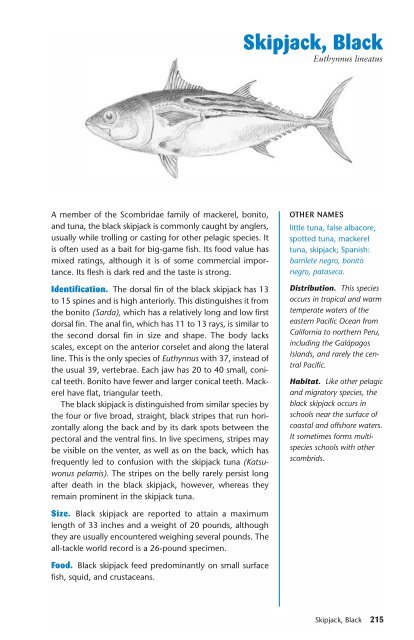Ken Schultz's Field Guide to Saltwater Fish - Macaw Pets store
Ken Schultz's Field Guide to Saltwater Fish - Macaw Pets store
Ken Schultz's Field Guide to Saltwater Fish - Macaw Pets store
Create successful ePaper yourself
Turn your PDF publications into a flip-book with our unique Google optimized e-Paper software.
A member of the Scombridae family of mackerel, boni<strong>to</strong>,<br />
and tuna, the black skipjack is commonly caught by anglers,<br />
usually while trolling or casting for other pelagic species. It<br />
is often used as a bait for big-game fish. Its food value has<br />
mixed ratings, although it is of some commercial importance.<br />
Its flesh is dark red and the taste is strong.<br />
Identification. The dorsal fin of the black skipjack has 13<br />
<strong>to</strong> 15 spines and is high anteriorly. This distinguishes it from<br />
the boni<strong>to</strong> (Sarda), which has a relatively long and low first<br />
dorsal fin. The anal fin, which has 11 <strong>to</strong> 13 rays, is similar <strong>to</strong><br />
the second dorsal fin in size and shape. The body lacks<br />
scales, except on the anterior corselet and along the lateral<br />
line. This is the only species of Euthynnus with 37, instead of<br />
the usual 39, vertebrae. Each jaw has 20 <strong>to</strong> 40 small, conical<br />
teeth. Boni<strong>to</strong> have fewer and larger conical teeth. Mackerel<br />
have flat, triangular teeth.<br />
The black skipjack is distinguished from similar species by<br />
the four or five broad, straight, black stripes that run horizontally<br />
along the back and by its dark spots between the<br />
pec<strong>to</strong>ral and the ventral fins. In live specimens, stripes may<br />
be visible on the venter, as well as on the back, which has<br />
frequently led <strong>to</strong> confusion with the skipjack tuna (Katsuwonus<br />
pelamis). The stripes on the belly rarely persist long<br />
after death in the black skipjack, however, whereas they<br />
remain prominent in the skipjack tuna.<br />
Size. Black skipjack are reported <strong>to</strong> attain a maximum<br />
length of 33 inches and a weight of 20 pounds, although<br />
they are usually encountered weighing several pounds. The<br />
all-tackle world record is a 26-pound specimen.<br />
Food. Black skipjack feed predominantly on small surface<br />
fish, squid, and crustaceans.<br />
Skipjack, Black<br />
Euthynnus lineatus<br />
OTHER NAMES<br />
little tuna, false albacore,<br />
spotted tuna, mackerel<br />
tuna, skipjack; Spanish:<br />
barrilete negro, boni<strong>to</strong><br />
negro, pataseca.<br />
Distribution. This species<br />
occurs in tropical and warm<br />
temperate waters of the<br />
eastern Pacific Ocean from<br />
California <strong>to</strong> northern Peru,<br />
including the Galápagos<br />
Islands, and rarely the central<br />
Pacific.<br />
Habitat. Like other pelagic<br />
and migra<strong>to</strong>ry species, the<br />
black skipjack occurs in<br />
schools near the surface of<br />
coastal and offshore waters.<br />
It sometimes forms multispecies<br />
schools with other<br />
scombrids.<br />
Skipjack, Black 215


